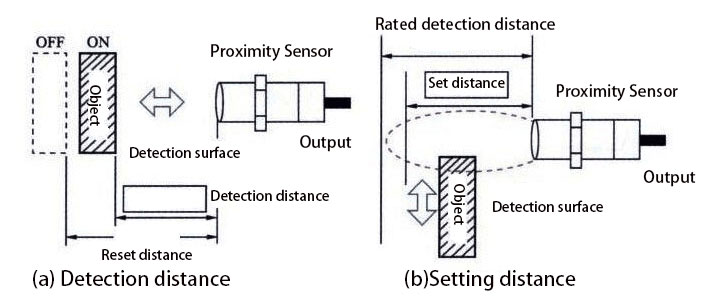How Does Proximity Sensor Work?
Proximity sensors are a class of important sensors widely used in industrial automation, automobile manufacturing, electronic equipment, and other fields. It can detect the presence or proximity of a target object, which triggers the corresponding action or control. ATO shop will delve into the structure of the proximity sensor, the principle of operation, the preparation for work and the work process, and other key points.
Proximity Sensor Structure
The structure of a proximity sensor mainly consists of a sensing element, an amplification circuit, and a housing and protection device. The sensing element is the core part, responsible for receiving external signals and converting them into electrical signals, common inductive sensors, and infrared sensors. Amplification circuits are used to enhance the weak signal output from the sensing element so that they can be more easily detected and processed. Different types of sensing elements are used in different application scenarios. Amplifier circuits are used to amplify the weak signal output from the sensing element so that they can be more easily detected and processed.

This section usually includes components such as amplifiers and filters to ensure stable and reliable sensor performance. The housing and protective devices are critical to the long-term stable operation of the sensor, preventing dust, moisture, chemicals, etc. from attacking the sensor and increasing its durability and reliability. Together, these three key components make up the robust and efficient structure of the proximity sensor, enabling it to work reliably in a wide range of environmental conditions.
Proximity Sensor Working Principle
Proximity sensors work based on different physical phenomena, commonly including inductive proximity sensors and infrared proximity sensors. Inductive proximity sensors work based on changes in the induced electromagnetic field. When a target object comes close to the sensor, it changes the inductive field around the proximity sensor, resulting in changes in induced currents and voltages. The proximity sensor measures these changes and converts them into an output signal to detect the presence or proximity of the target object.
Infrared proximity sensors, on the other hand, utilize the properties of infrared light. The proximity sensor detects the presence of a target object by emitting an infrared beam, and when the target object reflects the light back, the sensor receives a signal of the reflected light, and determines the location and distance of the target object by measuring the intensity and time delay of the signal. These operating principles allow proximity sensors to efficiently sense changes in the surrounding environment, providing important data support for automation systems.
Preparing Proximity Sensors for Work
To ensure the normal operation of the proximity sensor, a series of work preparations is required. First, ensure that the proximity sensor has a stable and reliable power supply, including voltage and current in line with the requirements of the proximity sensor. Second, carry out calibration and debugging work to ensure the accuracy and stability of the output of the proximity sensor by adjusting the amplification circuit, setting the sensitivity, and other parameters.
In the actual installation process, ensure that the proximity sensor is correctly installed in the target detection area and properly connected to avoid misuse. In addition, regular inspection and maintenance is also necessary to ensure that the proximity sensor's housing and protective devices are intact, to prevent dust, moisture, and other external factors from affecting the sensor.

Finally, depending on the specific application scenario, special environmental adaptation work may be required to ensure that the proximity sensor can operate properly in a variety of operating environments. The completion of these work preparation steps will help to improve the stability and life of the proximity sensor to ensure that it can function reliably in a variety of application scenarios.
Proximity Sensor Working Process
The working process of a proximity sensor consists of four key steps: Emitting signals, receiving signals, converting signals, and outputting results. First, the proximity sensor emits a specific type of signal, such as electromagnetic field, infrared, etc., depending on the type of proximity sensor. This signal travels through space and interacts with the target object. Second, the proximity sensor receives a signal that is reflected, scattered, or generated by the target object. This step is critical to the sensitivity and performance of the proximity sensor.
Next, the proximity sensor processes and enhances the weak signal received through amplification circuitry to make it easier to detect and analyze. Ultimately, the proximity sensor converts the processed signal into a voltage signal or digital signal and outputs it to a control system or other device. This output reflects the presence, location, or proximity of the target object. The process of proximity sensors may vary in different application scenarios. For example, for inductive proximity sensors, the operating process is based on induced electromagnetic field changes, while for infrared proximity sensors, the operating process is based on the reflection and reception of infrared light.
Whether for industrial automation, automotive manufacturing, or electronic devices, the efficient working processes of proximity sensors provide critical environmental sensing and control support for a wide range of applications. Through this series of steps, proximity sensors provide vital data feedback to automation systems as they monitor and respond to changes in targets in real-time, enabling a variety of applications to operate more intelligently.
As an integral part of modern industry and technology, proximity sensors provide powerful support for automation and intelligence in a variety of fields through their unique operating principles and structures. By gaining an in-depth understanding of proximity sensors' structure, operating principles, work preparation, and processes, we are better able to apply and maintain this important sensor technology.

